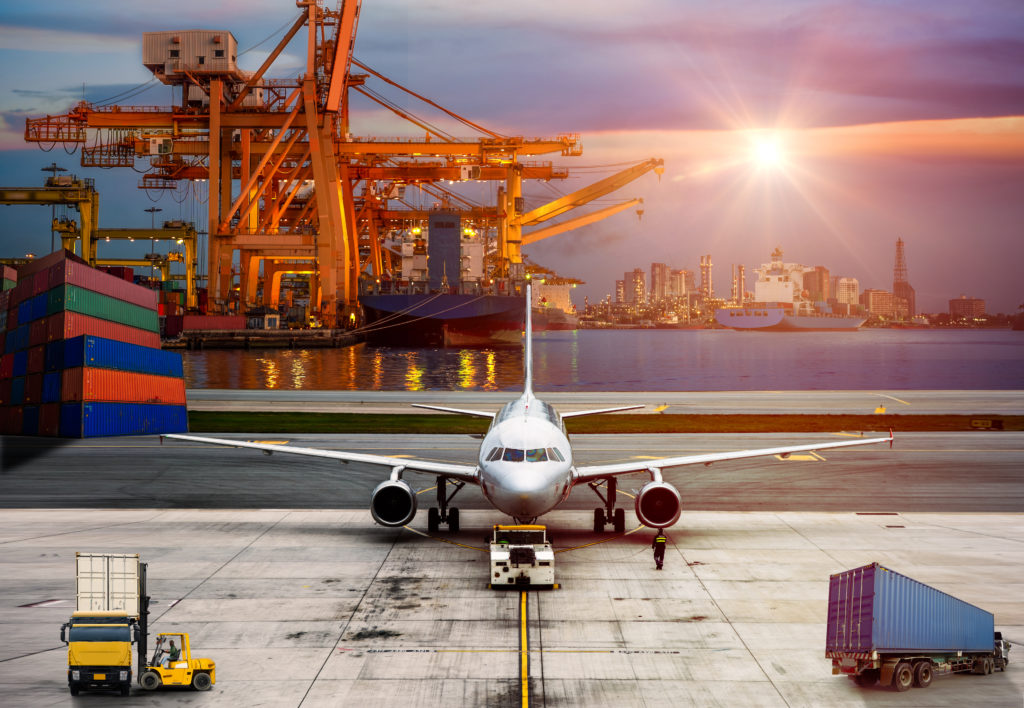Pesticides and Devices
Importing Pestisides and Devices
Federal Insecticide, Fungicide and Rodenticide Act (FIFRA)
United States Environmental Protection Agency (EPA) regulates pesticides under the Federal Insecticide, Fungicide and Rodenticide Act (FIFRA). FIFRA section 17 governs the import of pesticides and devices into, and the export of pesticides and devices from, the United States. Illegal importation of noncompliant pesticide products can result in pesticide misuse, illegal residues on food crops, human injury or exposure, and environmental damage.
All pesticides and devices imported into the United States must:
- Comply with U.S. pesticide law
- Be registered with EPA, except where exempted by regulation or statute (e.g. minimum risk pesticides) and as follows:
- Unregistered pesticides may be imported under certain conditions if intended for export (PR Notice 99-1)
- Emergency exemptions
- Not be adulterated or otherwise violative
- Properly labeled (in accordance with U.S. domestically produced pesticide labeling requirements)
- Produced in an EPA-registered establishment that files annual reports with the Agency
In-Depth Coverage: Country of Origin
- Country of Origin of Imported Merchandise
- Customs Ruling: Country of Origin
- Country of Origin: Food Products
- Country of Origin: Chemical and Pharmaceutical Products
- Country of Origin & Country of Manufacture: CBP vs. FDA
- Country of Origin: Substantial Transformation or Country of Assembly Test
- Country of Origin and Free Trade Agreement
- Country of Origin and Section 301
EPA Enforcement
EPA enforces requirements under FIFRA that governs the distribution, sale and use of pesticides or devices. EPA takes enforcement actions to address the:
- distribution or sale of unregistered pesticides,
- registered pesticides whose composition differs from that submitted at registration, and
- registered pesticides that are misbranded or adulterated.
Enforcement actions include:
- denial of entry,
- penalties for illegal distribution,
- issuing a Stop Sale, Use or Removal Order (SSURO) prohibiting the person who owns, controls, or has custody of a violative pesticide or device from selling, using, or removing that product.
Determining Filing Requirements:
To determine if you need to file the Pesticides Notice of Arrival (NOA) data and the on-product label, please check with the EPA Regional Import Coordinator for the appropriate port, to assist with determining pre-arrival filing requirements. Contacts for the regions can be found at:
Regional Contacts for Questions Concerning Notices of Arrival (EPA Form 3540-1)
In-Depth Coverage: Marketing and Advertising Compliance
- Federal Trade Commission (FTC) Advertising Rules
- Made in USA Standard
- FTC Regulation on Environmental Claims
- Adverting and Marketing on the Internet
- Label Claims for Conventional Foods and Dietary Supplements
- Dietary Supplement Advertising: What is FTC's Truth-in-Advertising Law?
- USDA Country of Origin Labeling (COOL)
- FTC Rules & Regulations on Food Advertisement
What are the options for filing a Pesticide Notice of Arrival (NOA)?
1. File a NOA in ACE:
File a NOA by typing into screens in your software and transmitting (what is referred to as the PGA Message Set) and upload an image of an on-product label to the Document Image System (DIS) (tagged as EPA04 -Pesticide Label). No mailing is required with the EPA Region. For registered Pesticides and Devices you may receive an automatic ‘may proceed’ if you file correctly.
2. File an EPA-signed NOA in the Document Image System (DIS):
File an image of an EPA-signed NOA by uploading an image of an acceptable file format to DIS (tagged as EPA03 -Pesticide). Mailing is required with the EPA Region. The NOA must first be completed and signed by the importer; mailed to the EPA region who will review, sign and return it; then upload to DIS. You will need to file a disclaim code C to show you have filed in DIS rather than the PGA Message Set. You will not receive an automated ‘may proceed’ message but will receive a one USG message and release if filed correctly.
3. File an EPA-signed NOA on paper:
File the paper NOA to accompany the shipment and file a disclaim code D in ACE. Mailing is required with the EPA Region. The NOA must first be completed and signed by the importer; mailed to the EPA region who will review, sign and return it; then provide it with your shipment. You will need to file a disclaim code D to show you have filed on paper rather than the PGA Message Set. You will not receive an automated ‘may proceed’ message.
In-Depth Coverage: Importing Medical Device
On-Product Labels
The importer should know the labeling requirements for their product and provide an EPA accepted legible label to the broker/filer. Note labeling requirements can vary by product. For more information on what is required for an on-product label see Chapter 3 in the following manual. For further information please refer to Label Review Manual
Note: U.S. Customs and Border Protection (CBP) regulations prohibit the importation of pesticides without a completed Notice of Arrival (NOA). The NOA indicates the identity and amount of the product, the arrival date, and where the product can be inspected. For paper submissions, the EPA-reviewed and signed paper form is returned to the importer for presentation to CBP's district director at the port of entry. For electronic filings via ACE, most of the filings are automatically processed, and an early indication is provided to the filer if the initial reporting requirements have been met and if the shipment can be released upon arrival at the port of entry. For electronic filings that do not meet the reporting requirements, automatic checks will be performed to notify the filer of errors. For electronic filings that require non-automated checks, EPA staff can review and provide feedback notifications through ACE to the filer on what information is needed that has not been provided. After arrival, EPA may inspect the shipment for compliance with U.S. pesticide laws.
Importing Foods Containing Pestiside Residues
EPA sets limits on how much of a pesticide residue can remain on food and feed products, or commodities. These pesticide residue limits are known as tolerances. Tolerances are set to protect you from harmful levels of pesticides on your food.
For more information about tolerance please refer to “Regulation of Pesticide Residues on Food”
In-Depth Coverage: Importing Food Products
- What is FDA Food Safety Modernization Act (FSMA)?
- Prior Notice of Imported Foods
- FDA Food Facility Registration
- Risk-Based Preventive Controls for Human Food
- Risk-Based Preventive Control for Animal Food
- Protect Food against Intentional Adulteration
- What is Foreign Supplier Verification Program (FSVP)?
- What is FSMA Produce Safety Rule?
In-Depth Coverage: Importing Cosmetics
Quick Link To U.S. Customs & Import Requirements
Customs Clearance and Import Requirements
- Entry of Imported Merchandise
- What is Section 321 Entry?
- What is Automated Commercial Environment (ACE)
- What is an Automated Broker Interface (ABI)?
- Who is Ultimate Consignee?
- What is Non-Resident Importer Program?
- Country of Origin of Imported Merchandise
- What is the Country of Assembly?
- What is the FDA's Country of Manufacture?
- Marking of Country of Origin on U.S. Imports
- What is Customs Bond?
- Reconciliation Prototype and Bond Rider
- Who Needs a Customs Broker?
- What is Customs Ruling Program?
- Classification of Imported Goods
- How is imported merchandise appraised?
- What are Import Quotas?
- What are Trade Remedy Duties?
- Antidumping Duty (AD) and Countervailing Duty (CVD)
- What is Foreign Trade Zone (FTZ)?
- What is Importer Security Filing (ISF)?
- What is Temporary Importation under Bond (TIB)
- What is In-Bond Process?
FDA-Regulated Products and Import Requirements
- What is Food Safety Modernization Act (FSMA)?
- Prior Notice of Imported Foods
- Food Facility Registration
- Risk-Based Preventive Controls for Human Food
- Risk-Based Preventive Control for Animal Food
- Standards for the Growing, Harvesting, Packing, and Holding of Produce for Human Consumption
- What is Foreign Supplier Verification Program (FSVP)?
- Protect Food against Intentional Adulteration
- FDA Regulated Product in Foreign Trade Zone (FTZ)
- Entry Review Process for FDA Regulated Products
- Country of Origin VS Country of Manufacture
- Foods Regulated by FDA or USDA: What is the Difference?
- Label and Labeling Claims for Conventional Food and Dietary Supplements
- What is USDA Country of Origin Labeling (COOL)?
- Import for Export of FDA Regulated Products
- FDA Regulated Products in Personal Baggage or Sending by Mail or Courier
- International Mail Facility (IMF) and FDA Regulation
- Importing Biological Product Regulated by CBER
- Importing Cosmetics and Voluntary Cosmetic Registration Program (VCRP)
- Importing Drugs into the U.S.
- Importing OTC Drugs into the U.S.
- Importing Veterinary Drugs into the U.S.
- Importing Tobacco Products into the U.S.
- Importing Medical Devices into the U.S
- Importing Food Products into he U.S.
- Importing Radiation-Emitting Products into the U.S.
Guidance on customs & logistics solution for traditional and e-commerce importers and exporters
Importer Security Filing (ISF)
An ISF is required when cargo (ocean only) laden on vessel at a foreign port is destined for shipment to the U.S. Under ISF rule, some importing information and details regarding cargo must be transmitted to the CBP at least 24 hours before goods are loaded onto the vessel, or at least 24 hours prior to the departure to the U.S.
Freight Forwarding
Looking for a freight forwarding partner? To move your cargo from its current location through customs to its final destination we will partner with you to find the best way for your business. Whatever your transportation, logistics or customs clearance needs, we will do our best to customize a solution for your needs.
Customs Clearance
All goods imported into the customs territory of the U.S. are required to be declared to CBP. Our customs broker will help you stay in compliance with customs laws and regulations and clear your goods quickly and efficiently with our electronic Automated Commercial Environment (ACE) and Automated Broker Interface (ABI) Single Window System.
Section 321 Entry
Section 321 entry allows importing free of duty and tax for shipments imported by one person on one day having a fair retail value in the country of shipment not more than $800. We provide our resident and non-resident clients with dedicated ACE eManifest solutions for Section 321 entry of all modes of transportation.
Non-resident Importer Program
If you want to sell your products in U.S. marketplaces, but you are a business owner located outside of the U.S. and do not have an entity or presence in the U.S., you need to be established as a Foreign Importer of Record before your products can be imported into the U.S. We can help you.
E-Commerce
The Internet has made it easy to find and purchase items from almost anywhere in the world. Our e-commerce experts will help you find the right solution for your international transportation, customs clearance, and delivery to your final destination. We also provide value-added repackaging, warehousing and distribution services.























